实验3:OpenFlow协议分析实践
基本要求
一、拓扑文件

二、Wireshark抓包结果
1.hello
控制器6633端口 ---> 交换机34614端口
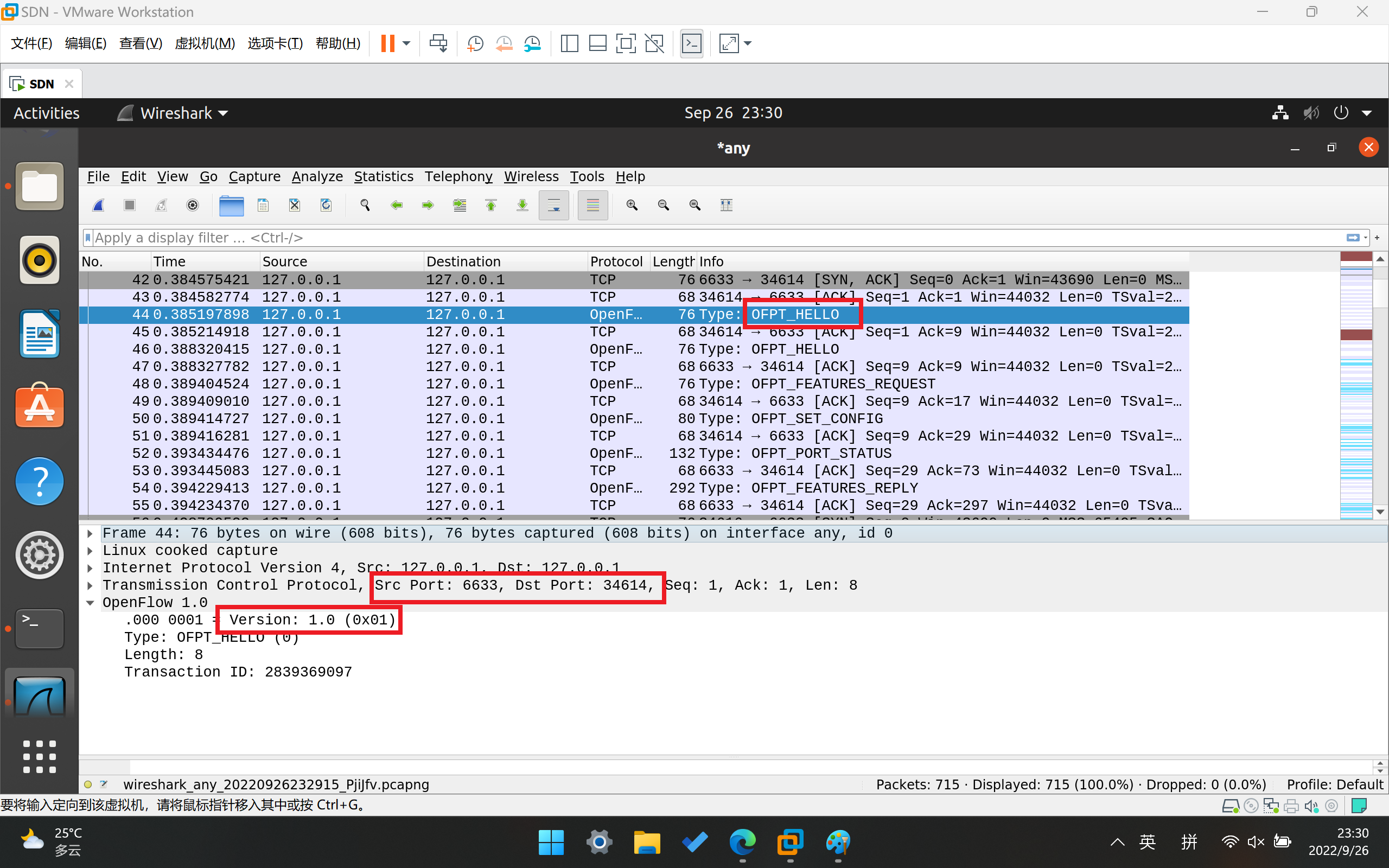
交换机34614端口 ---> 控制器6633端口
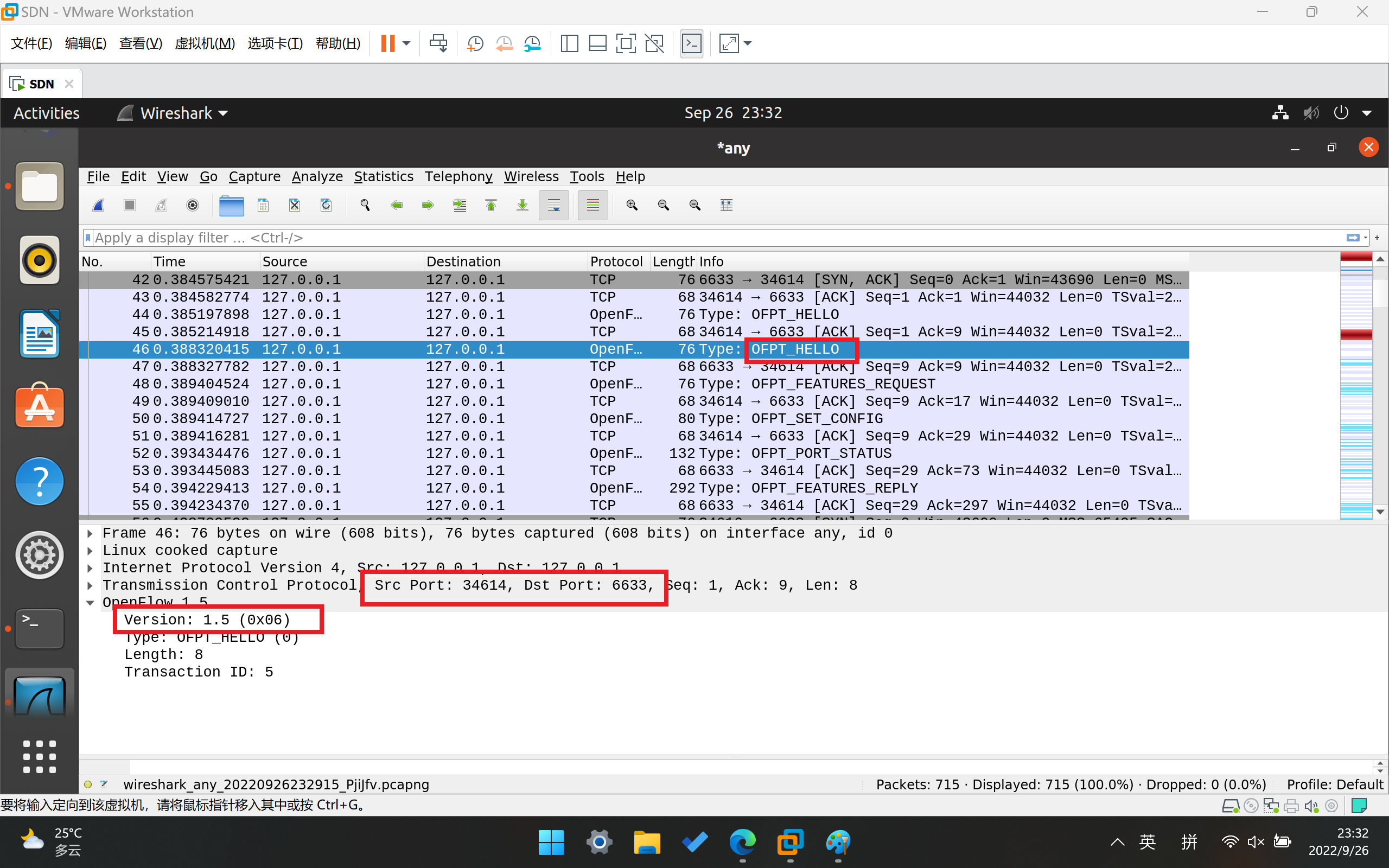
2.Features Request
控制器6633端口(我需要你的特征信息) ---> 交换机34614端口

3.Set Config
控制器6633端口(请按照我给你的flag和max bytes of packet进行配置) ---> 交换机34614端口

4.Port_Status
当交换机端口发生变化时,告知控制器相应的端口状态。
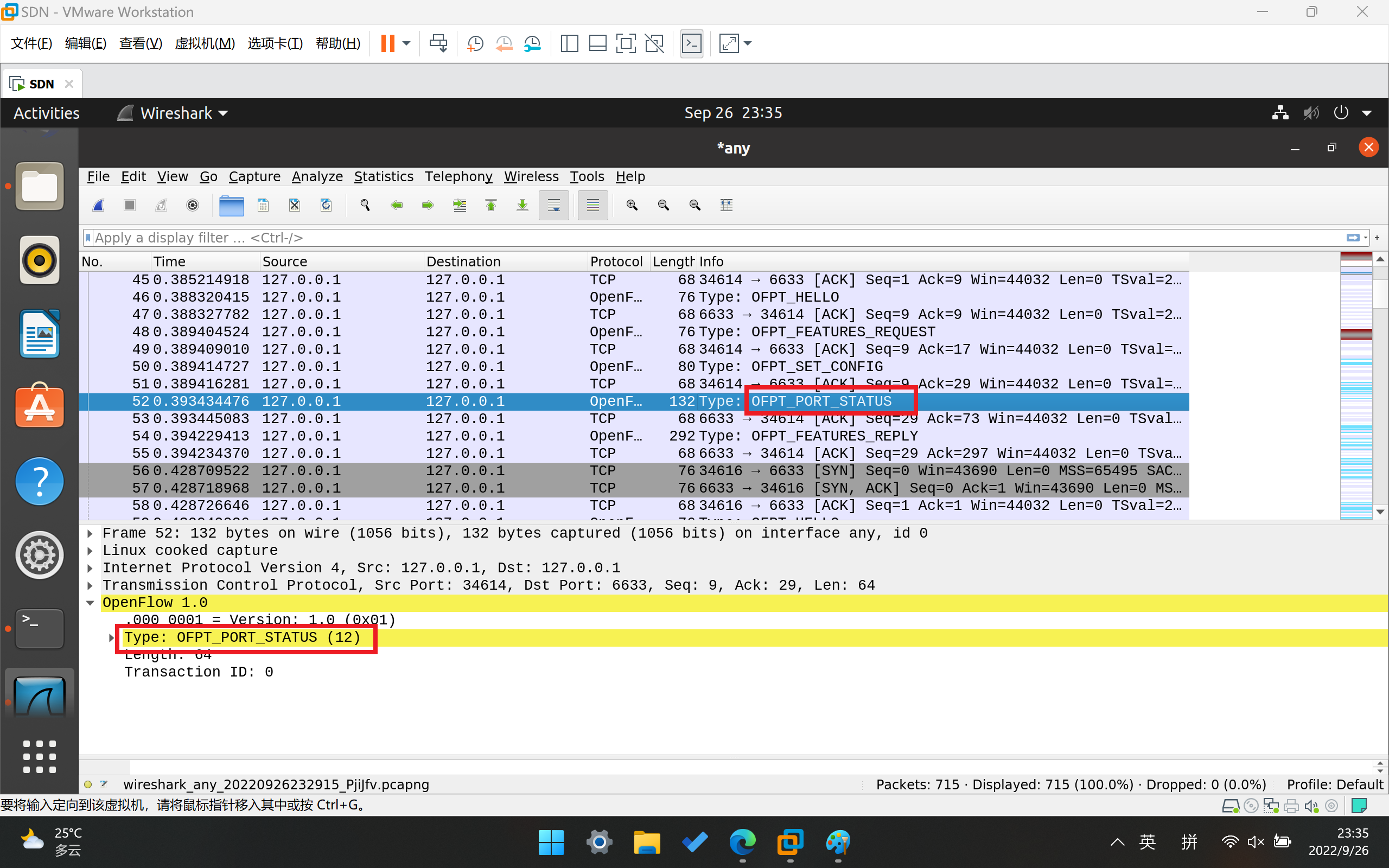
5.Features Reply
交换机端口43614(这是我的特征信息,请查收) ---> 控制器6633端口

6.Packet_In
交换机43614端口(有数据包进来,请指示)--- 控制器6633端口
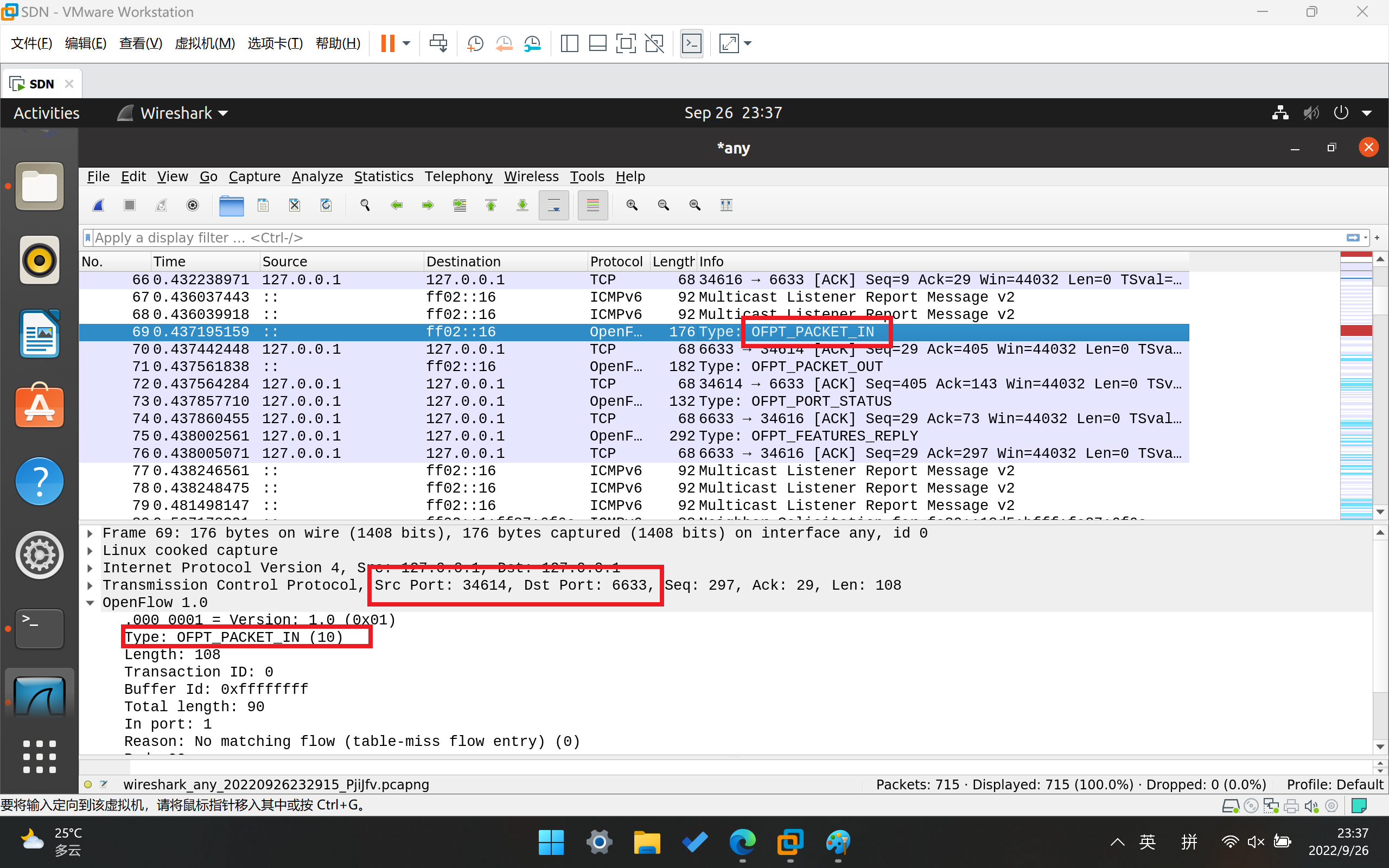
7.Flow_Mod
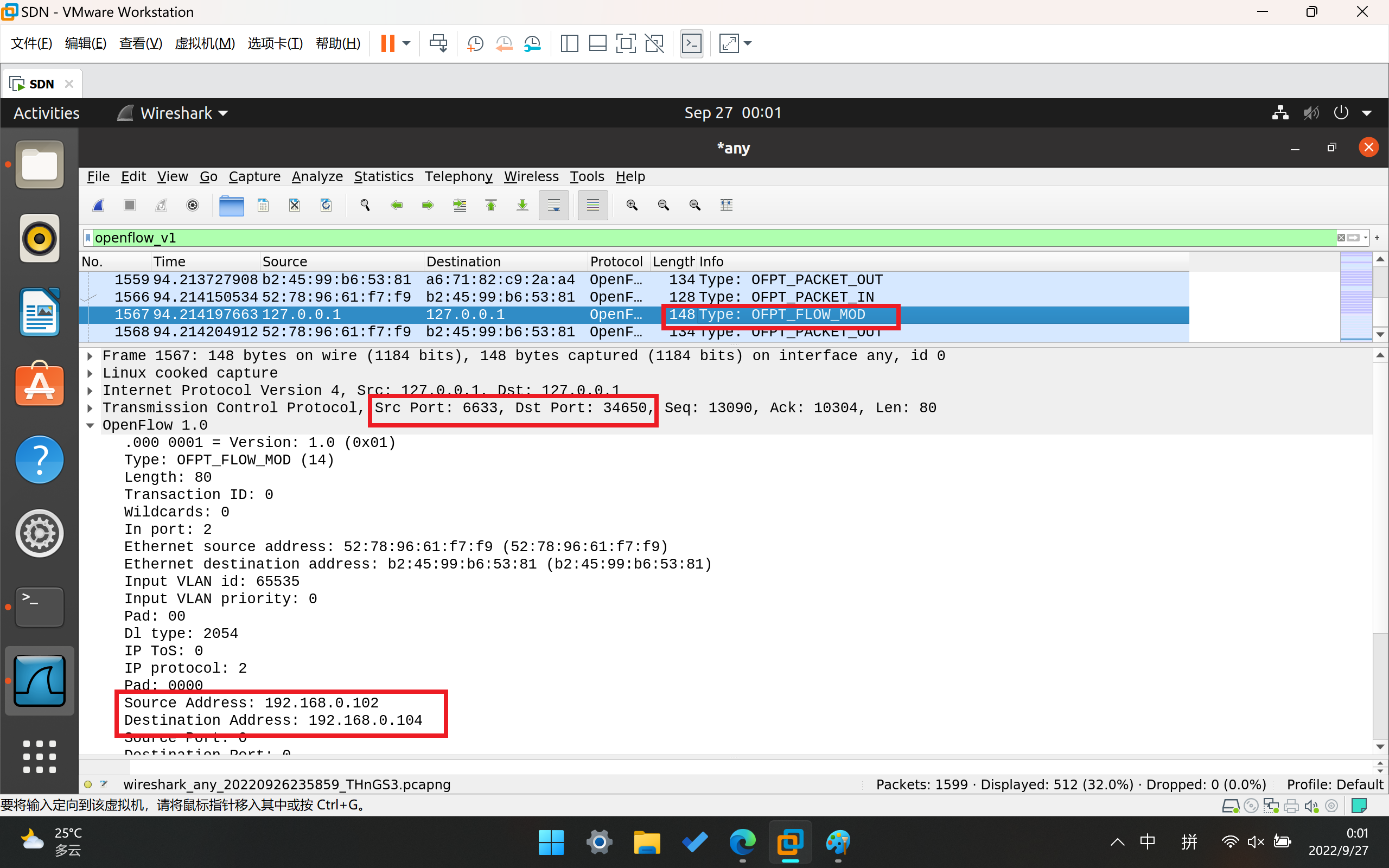
8.Packet_Out
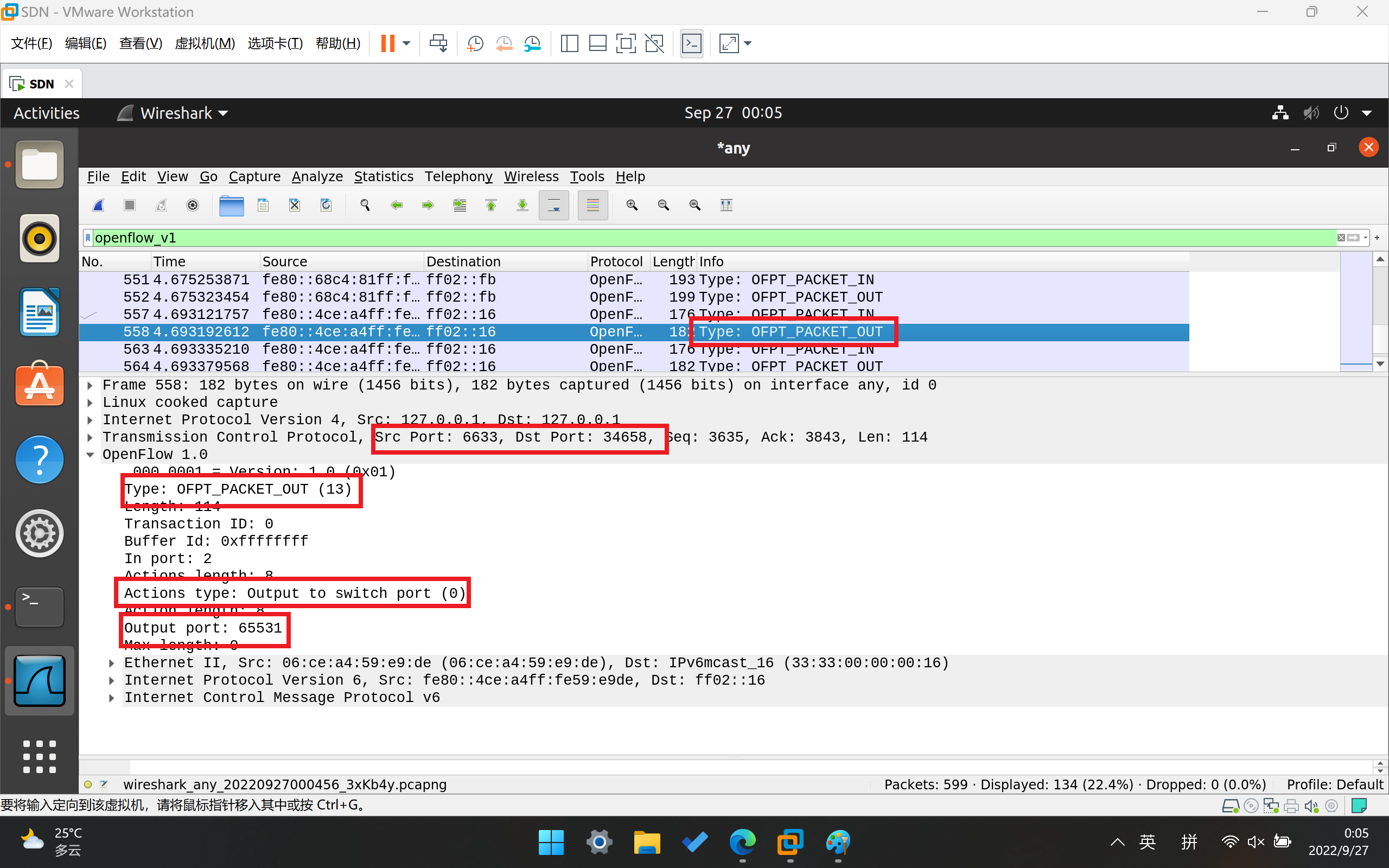
三、查看抓包结果,分析OpenFlow协议中交换机与控制器的消息交互过程,画出相关交互图或流程图
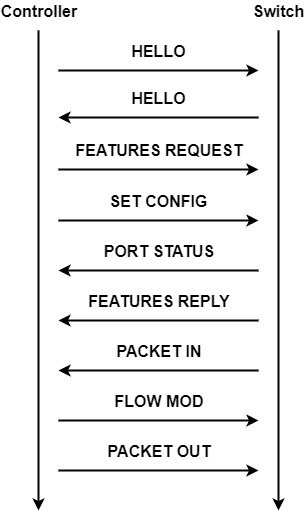
四、交换机与控制器建立通信时是使用TCP协议还是UDP协议?
TCP协议
进阶要求
1.hello
struct ofp_header {
uint8_t version; /* OFP_VERSION. */
uint8_t type; /* One of the OFPT_ constants. */
uint16_t length; /* Length including this ofp_header. */
uint32_t xid; /* Transaction id associated with this packet.
Replies use the same id as was in the request
to facilitate pairing. */
};
struct ofp_hello {
struct ofp_header header;
};


2.Features Request
struct ofp_header {
uint8_t version; /* OFP_VERSION. */
uint8_t type; /* One of the OFPT_ constants. */
uint16_t length; /* Length including this ofp_header. */
uint32_t xid; /* Transaction id associated with this packet.
Replies use the same id as was in the request
to facilitate pairing. */
};
struct ofp_hello {
struct ofp_header header;
};

3.Set Config
/* Switch configuration. */
struct ofp_switch_config {
struct ofp_header header;
uint16_t flags; /* OFPC_* flags. */
uint16_t miss_send_len; /* Max bytes of new flow that datapath should
send to the controller. */
};

4.Port_Status
/* A physical port has changed in the datapath */
struct ofp_port_status {
struct ofp_header header;
uint8_t reason; /* One of OFPPR_*. */
uint8_t pad[7]; /* Align to 64-bits. */
struct ofp_phy_port desc;
};

5.Features Reply
struct ofp_switch_features {
struct ofp_header header;
uint64_t datapath_id; /* Datapath unique ID. The lower 48-bits are for
a MAC address, while the upper 16-bits are
implementer-defined. */
uint32_t n_buffers; /* Max packets buffered at once. */
uint8_t n_tables; /* Number of tables supported by datapath. */
uint8_t pad[3]; /* Align to 64-bits. */
/* Features. */
uint32_t capabilities; /* Bitmap of support "ofp_capabilities". */
uint32_t actions; /* Bitmap of supported "ofp_action_type"s. */
/* Port info.*/
struct ofp_phy_port ports[0]; /* Port definitions. The number of ports
is inferred from the length field in
the header. */
};
/* Description of a physical port */
struct ofp_phy_port {
uint16_t port_no;
uint8_t hw_addr[OFP_ETH_ALEN];
char name[OFP_MAX_PORT_NAME_LEN]; /* Null-terminated */
uint32_t config; /* Bitmap of OFPPC_* flags. */
uint32_t state; /* Bitmap of OFPPS_* flags. */
/* Bitmaps of OFPPF_* that describe features. All bits zeroed if
* unsupported or unavailable. */
uint32_t curr; /* Current features. */
uint32_t advertised; /* Features being advertised by the port. */
uint32_t supported; /* Features supported by the port. */
uint32_t peer; /* Features advertised by peer. */
};

6.Packet_In
/* Why is this packet being sent to the controller? */
enum ofp_packet_in_reason {
OFPR_NO_MATCH, /* No matching flow. */
OFPR_ACTION /* Action explicitly output to controller. */
};
/* Packet received on port (datapath -> controller). */
struct ofp_packet_in {
struct ofp_header header;
uint32_t buffer_id; /* ID assigned by datapath. */
uint16_t total_len; /* Full length of frame. */
uint16_t in_port; /* Port on which frame was received. */
uint8_t reason; /* Reason packet is being sent (one of OFPR_*) */
uint8_t pad;
uint8_t data[0]; /* Ethernet frame, halfway through 32-bit word,
so the IP header is 32-bit aligned. The
amount of data is inferred from the length
field in the header. Because of padding,
offsetof(struct ofp_packet_in, data) ==
sizeof(struct ofp_packet_in) - 2. */
};

7.Flow_Mod
struct ofp_flow_mod {
struct ofp_header header;
struct ofp_match match; /* Fields to match */
uint64_t cookie; /* Opaque controller-issued identifier. */
/* Flow actions. */
uint16_t command; /* One of OFPFC_*. */
uint16_t idle_timeout; /* Idle time before discarding (seconds). */
uint16_t hard_timeout; /* Max time before discarding (seconds). */
uint16_t priority; /* Priority level of flow entry. */
uint32_t buffer_id; /* Buffered packet to apply to (or -1).
Not meaningful for OFPFC_DELETE*. */
uint16_t out_port; /* For OFPFC_DELETE* commands, require
matching entries to include this as an
output port. A value of OFPP_NONE
indicates no restriction. */
uint16_t flags; /* One of OFPFF_*. */
struct ofp_action_header actions[0]; /* The action length is inferred
from the length field in the
header. */
};
struct ofp_action_header {
uint16_t type; /* One of OFPAT_*. */
uint16_t len; /* Length of action, including this
header. This is the length of action,
including any padding to make it
64-bit aligned. */
uint8_t pad[4];
};

8.Packet_Out
/* Send packet (controller -> datapath). */
struct ofp_packet_out {
struct ofp_header header;
uint32_t buffer_id; /* ID assigned by datapath (-1 if none). */
uint16_t in_port; /* Packet's input port (OFPP_NONE if none). */
uint16_t actions_len; /* Size of action array in bytes. */
struct ofp_action_header actions[0]; /* Actions. */
/* uint8_t data[0]; */ /* Packet data. The length is inferred
from the length field in the header.
(Only meaningful if buffer_id == -1.) */
};

个人总结
这次实验其实没有需要操作的地方,更多的是对于OpenFlow协议的分析,通过Wireshark对OpenFlow 协议数据交互过程进行抓包,从而能够理解与分析 OpenFlow协议的数据包交互过程与机制。
在OpenFlow1.3协议的情况下,控制器与OpenFlow交换机的消息完整交互流程如下:
1、 控制器与OpenFlow交换机通过TCP“三次握手”,建立有效的连接。其中,控制器一端的端口号为6633。
2、 控制器与OpenFlow交换机之间相互发送Hello消息,用于协商双方的OpenFlow版本号。在双方支持的最高版本号不一致的情况下,协商的结果将以较低的OpenFlow版本为准。
3、 控制器向OpenFlow交换机发送Features Request消息,请求OpenFlow交换机上传自己的详细参数。OpenFlow交换机收到请求后,向控制器发送Features Reply消息,详细汇报自身参数,包括支持的buffer数目、流表数以及Actions等。
4、 控制器通过Set Config消息下发配置参数,然后通过Get config Request消息请求OpenFlow交换机上传修改后的配置信息。OpenFlow交换机通过Get config Reply消息向控制器发送当前的配置信息。
5、 控制器与OpenFlow交换机之间发送Packet_out、Packet_in消息,通过Packet_out中内置的LLDP包,进行网络拓扑的探测。
6、 控制器与OpenFlow交换机之间通过发送Multipart Request、Mutipart Reply消息,控制器能获取OpenFlow交换机的状态信息,包括流的信息、端口信息等。
7、 控制器与OpenFlow交换机之间通过发送Echo Request、Echo Reply消息,保证二者之间存在有效连接,避免失联。
遇到过这样的问题:就是一开始找不到 FLOW_MOD ,后来通过在 CLI 中执行 pingall 命令后,便能够找到了。



 浙公网安备 33010602011771号
浙公网安备 33010602011771号